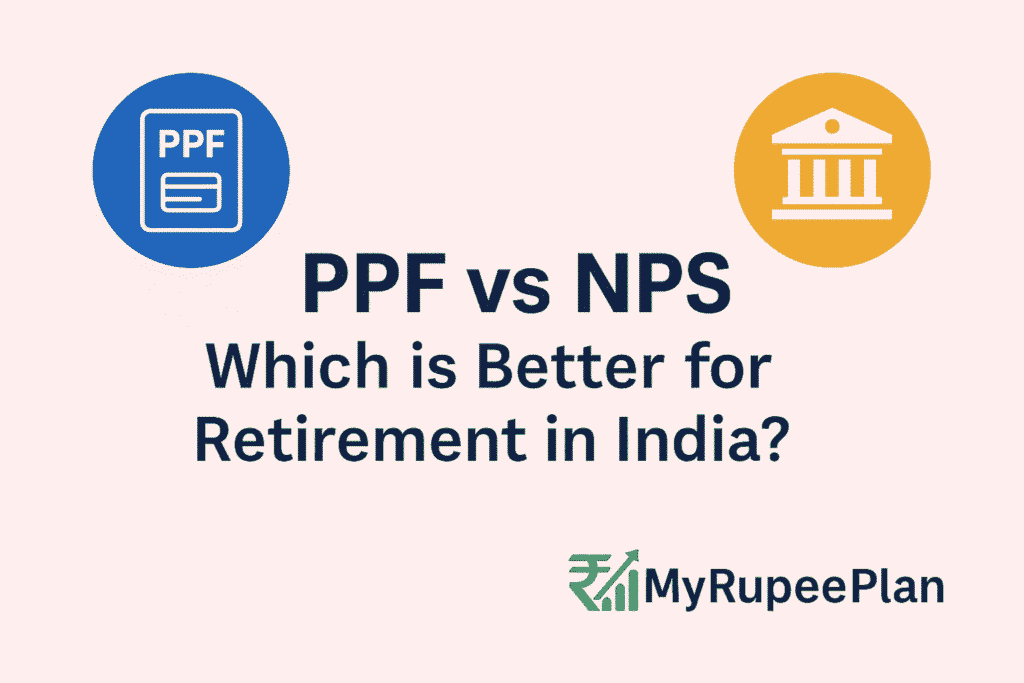PPF vs NPS: Which is Better for Retirement in India?
Why Choosing the Right Retirement Plan Matters
Planning for retirement is one of the most critical aspects of personal finance. Among the many options available, the Public Provident Fund (PPF) and the National Pension System (NPS) stand out as two of the most popular long-term investment schemes in India. But when it comes to PPF vs NPS, which one is better for your retirement?
In this guide, we’ll compare both options based on returns, safety, tax benefits, liquidity, and suitability to help you make the right choice.

🏦 What is PPF?
The Public Provident Fund (PPF) is a government-backed savings scheme aimed at encouraging long-term investments by offering guaranteed returns and tax benefits. It is best suited for conservative investors seeking risk-free retirement savings.
🔹 Key Features of PPF:
- Interest Rate: ~7.1% per annum (compounded annually)
- Tenure: 15 years (extendable in 5-year blocks)
- Risk: Zero (government-backed)
- Taxation: EEE (Exempt-Exempt-Exempt)
- Max Investment: ₹1.5 lakh/year
- Withdrawal: Partial after 7 years; full on maturity
💼 What is NPS?
The National Pension System (NPS) is a voluntary, market-linked retirement product regulated by the PFRDA. It allows individuals to invest in a mix of equity, corporate debt, and government bonds.
 Key Features of NPS:
Key Features of NPS:
- Interest Rate: 8%–10% (market-linked)
- Tenure: Till retirement (minimum 60 years)
- Risk: Moderate to high (depends on asset allocation)
- Taxation: Partially exempt (60% corpus tax-free at maturity)
- Max Investment: No upper limit
- Withdrawal: 60% lump sum, 40% annuity (mandatory)
🔍 PPF vs NPS: A Detailed Comparison
| Feature | PPF | NPS |
|---|---|---|
| Returns | ~7.1% (fixed) | 8%–10% (market-linked) |
| Risk Level | Very Low | Moderate to High |
| Lock-in Period | 15 years | Till age 60 |
| Liquidity | Partial withdrawal after 7 years | Partial after 3 years (Tier II) |
| Tax Treatment | EEE (fully tax-free) | EEE (partial) |
| Flexibility | Fixed annual deposits | Choose equity/debt ratio |
| Ideal For | Conservative investors | Long-term growth-focused investors |
💸 Tax Benefits: PPF vs NPS
✅ PPF Tax Benefits
- Investment eligible for deduction under Section 80C
- Interest earned is tax-free
- Maturity amount is 100% tax-free
✅ NPS Tax Benefits
- ₹1.5 lakh deduction under Section 80C
- Additional ₹50,000 under Section 80CCD(1B)
- 60% corpus at maturity is tax-free; 40% goes into annuity (taxable as per slab)
📌 Verdict: NPS offers higher tax-saving potential for those investing beyond ₹1.5 lakh/year.
💸 Tax Benefits: PPF vs NPS
Choose PPF if:
- You want guaranteed returns without market risk
- You’re a conservative investor
- You prefer 100% tax-free maturity
Choose NPS if:
- You want higher returns over the long term
- You’re comfortable with market-linked investments
- You want to maximise tax deductions (up to ₹2 lakh)
💡 Pro Tip: You don’t need to choose one over the other. You can invest in both — use PPF for guaranteed savings and NPS for long-term growth.
💬 Frequently Asked Questions (FAQs)
Q1. Which has better returns: PPF or NPS?
NPS generally offers higher returns (8%–10%) compared to PPF (~7.1%) but comes with market risk.
Q2. Is PPF safer than NPS?
Q3. Can I invest in both PPF and NPS?
Q4. Is the maturity amount from NPS tax-free?
Q5. Which is better for self-employed individuals?
Self-employed investors can benefit from both. PPF offers stability, while NPS provides flexibility and tax advantages.
📝 Final Verdict: PPF vs NPS — Which Wins?
Both PPF and NPS serve different purposes in a retirement plan.
- Choose PPF if you prioritise safety, tax-free maturity, and fixed returns.
- Choose NPS if you aim for higher long-term growth, tax savings, and don’t mind some market exposure.
For most investors, a combination of both provides the best of both worlds: guaranteed income + market-based growth.
